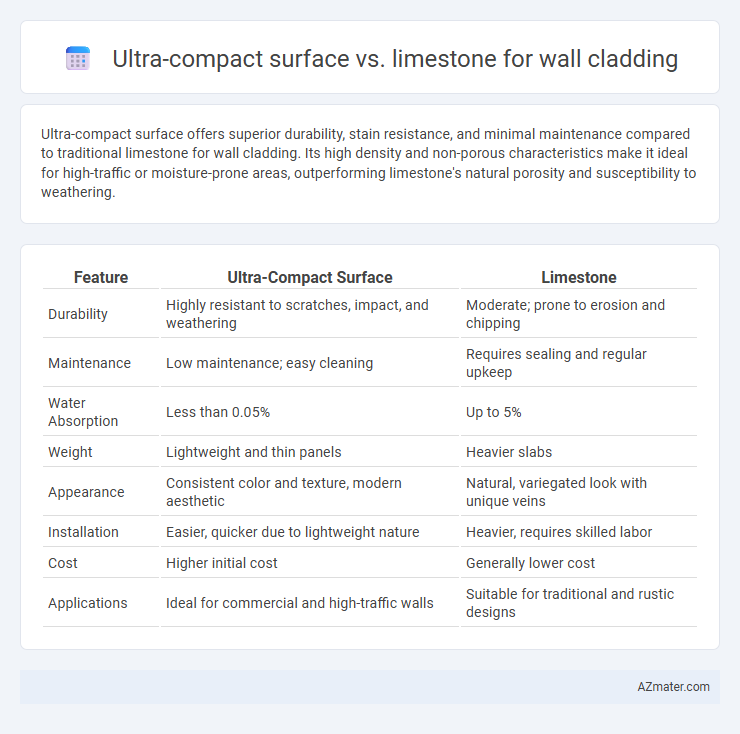Ultra-compact surface offers superior durability, stain resistance, and minimal maintenance compared to traditional limestone for wall cladding. Its high density and non-porous characteristics make it ideal for high-traffic or moisture-prone areas, outperforming limestone's natural porosity and susceptibility to weathering.
Table of Comparison
| Feature | Ultra-Compact Surface | Limestone |
|---|---|---|
| Durability | Highly resistant to scratches, impact, and weathering | Moderate; prone to erosion and chipping |
| Maintenance | Low maintenance; easy cleaning | Requires sealing and regular upkeep |
| Water Absorption | Less than 0.05% | Up to 5% |
| Weight | Lightweight and thin panels | Heavier slabs |
| Appearance | Consistent color and texture, modern aesthetic | Natural, variegated look with unique veins |
| Installation | Easier, quicker due to lightweight nature | Heavier, requires skilled labor |
| Cost | Higher initial cost | Generally lower cost |
| Applications | Ideal for commercial and high-traffic walls | Suitable for traditional and rustic designs |
Understanding Ultra-Compact Surfaces and Limestone
Ultra-compact surfaces consist of highly compressed natural materials like quartz, porcelain, and glass, offering exceptional durability, stain resistance, and low porosity ideal for wall cladding applications. Limestone, a sedimentary rock primarily composed of calcite, provides a natural, textured aesthetic but is more porous and susceptible to weathering and staining compared to ultra-compact surfaces. Understanding the physical properties of ultra-compact surfaces reveals superior resistance to impact and chemical damage, making them a low-maintenance alternative to traditional limestone for long-lasting wall cladding.
Key Properties of Ultra-Compact Surfaces
Ultra-compact surfaces exhibit exceptional durability, high resistance to scratches, stains, and UV rays, making them ideal for wall cladding applications. Their non-porous structure ensures low water absorption and enhanced hygienic properties compared to limestone, which is more porous and prone to weathering. Ultra-compact surfaces provide superior mechanical strength, ease of maintenance, and a wide range of colors and finishes, offering versatile design options without compromising longevity.
Unique Characteristics of Limestone for Cladding
Limestone for wall cladding offers unique characteristics such as natural durability, excellent thermal insulation, and a timeless aesthetic with its warm, earthy tones and subtle textures. Its porous nature provides breathability, reducing moisture buildup and enhancing indoor air quality. Unlike ultra-compact surfaces, limestone weathers gracefully over time, developing a patina that adds character and authenticity to architectural facades.
Durability Comparison: Ultra-Compact Surface vs Limestone
Ultra-compact surfaces exhibit superior durability compared to limestone, offering high resistance to scratches, stains, and impacts due to their dense, non-porous composition. Limestone, a sedimentary rock, is more susceptible to weathering, erosion, and chemical damage, making it less ideal for high-traffic or exposed wall cladding applications. The robust nature of ultra-compact materials ensures longer-lasting wall finishes with minimal maintenance requirements in both interior and exterior environments.
Aesthetic Appeal and Design Versatility
Ultra-compact surfaces offer a sleek, modern aesthetic with a consistent texture and color palette, enhancing minimalist and contemporary designs. Limestone provides a natural, textured appearance with unique veining and tonal variations, ideal for creating timeless and rustic wall cladding. Design versatility is higher with ultra-compact surfaces due to their adaptability to large formats and various finishes, while limestone is favored for its organic charm and classic elegance in architectural applications.
Weather Resistance and Maintenance Needs
Ultra-compact surfaces offer superior weather resistance compared to limestone, exhibiting high durability against UV exposure, moisture, and temperature fluctuations without fading or erosion. Limestone, being a porous natural stone, is more prone to weathering, discoloration, and surface degradation when exposed to harsh environmental conditions. Maintenance for ultra-compact surfaces is minimal due to their non-porous structure, requiring only occasional cleaning, while limestone demands regular sealing and more intensive upkeep to prevent staining and weather damage.
Environmental Impact and Sustainability
Ultra-compact surfaces offer lower environmental impact compared to limestone due to their manufacturing process that utilizes recycled materials and requires less quarrying, reducing habitat disruption. Limestone extraction often leads to significant landscape alteration and carbon emissions from mining and transportation, negatively affecting local ecosystems. Ultra-compact materials also provide enhanced durability and resistance to weathering, leading to longer lifespans and less frequent replacement, which contributes to sustainable building practices.
Installation Methods and Practical Considerations
Ultra-compact surfaces for wall cladding offer seamless installation through adhesive bonding or mechanical fastening, providing high durability and resistance to stains, scratches, and UV exposure. Limestone requires more careful handling during installation due to its porous and softer nature, necessitating proper sealing and anchoring techniques to prevent damage and moisture infiltration. Choosing ultra-compact surfaces reduces maintenance efforts and enhances longevity in high-traffic or exterior wall applications compared to traditional limestone cladding.
Cost Analysis: Upfront and Long-Term Value
Ultra-compact surfaces for wall cladding often have a higher upfront cost compared to natural limestone due to advanced manufacturing processes and material durability. Limestone, while generally less expensive initially, may incur higher long-term maintenance and repair expenses due to its porous nature and susceptibility to weathering. Evaluating total cost of ownership reveals ultra-compact surfaces offer better value over time, combining low maintenance requirements with superior resistance to stains, scratches, and environmental damage.
Best Applications: Choosing the Right Material for Your Project
Ultra-compact surfaces excel in high-traffic and moisture-prone areas due to their durability, low porosity, and resistance to stains, making them ideal for kitchens, bathrooms, and commercial spaces. Limestone, with its natural texture and warm aesthetic, is best suited for decorative wall cladding in residential interiors and accent walls where a classic, elegant look is desired but durability demands are moderate. Selecting between ultra-compact surface and limestone depends on project requirements such as maintenance, exposure to elements, and desired visual impact.

Infographic: Ultra-compact surface vs Limestone for Wall Cladding
 azmater.com
azmater.com